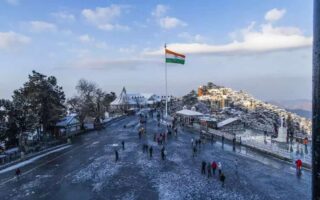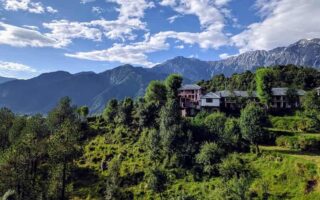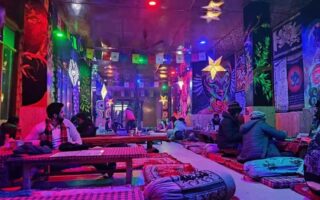Himachal Pradesh is completely a mountainous state and a pleasure for all the visitors, mainly during the spring season when people flock to this tiny hill station to run away from the sweltering warmth of the plain areas. The present form of land is because of the detachment of Punjab into Haryana and Punjab in the year 1966. Elevated points of the state of Himachal are as tagged on. The high passes and the winding roads connect its high valleys and mountains.
Viceregal Lodge which is known as “Rashtrapati Niwas” in Shimla which is domicile of the Institution of Advanced Studies with its premises is one of the prime locations among the Monuments in Himachal Pradesh. Just 4 kms away from the city of Dharamshala is the Norbulingka Institute of Tibetan Culture with beautiful landscapes and gardens, this institute includes a museum and a traditional temple that houses ornately carved woodwork, ‘thangka’ paintings, carpet weaving and other carving. Additionally, the Monuments in Himachal Pradesh is Lord Elgin’s Memorial in Dharamshala, situated inside the wilderness of St. John’s Church. The Maharaja Palace of Chail has now been converted into a hotel, offering its visitors attractive and comfortable stay. Do not forget to visit the historical Gurkha Castles and Forts located in Solan, Sirmour, Bilaspur and Shimla districts.
There are many Monuments in Himachal Pradesh namely War Memorial, Rang Mahal, Namgyal Monastery and many more on the list.
Namgyal Monastery
- Region : Dharamshala
- Established In : 1575
- Another Name : Namgyal Dratsang
- Established By: 3rd Dalai Lama Sonam Gyatso
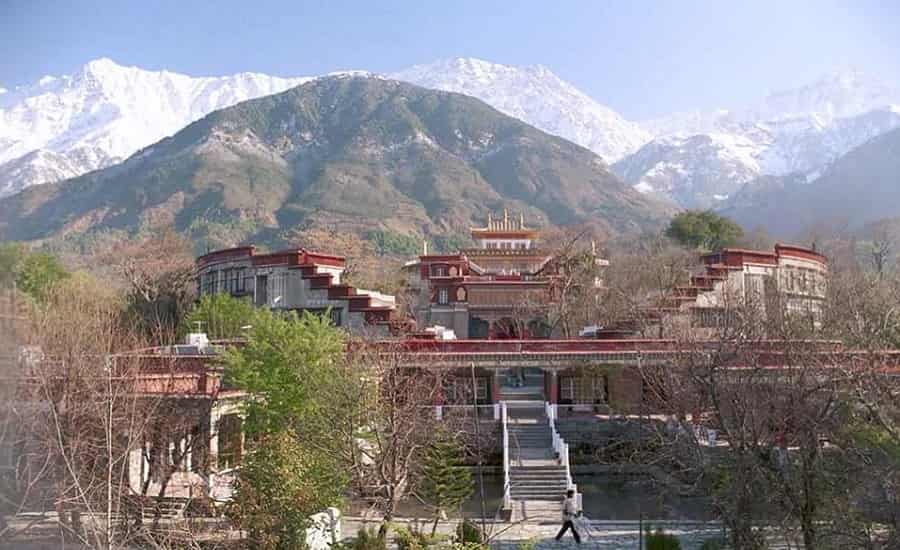
During the year of 1575, the great 3rd Dalai Lama had established a sacred monastery, after some time this monastery became popular as Namgyal Dratsang. From its start, this holy monastery was assisting Dalai Lamas with their public spiritual activities & practiced religious prayer functions to create welfare within Tibet. From the starting days of the monastery, it was a prime point of learning, meditation and contemplation on deep Buddhist contract. This monastery is nonsectarian & it holds teaching and spiritual practices of 4 major ancestries of Tibet’s Buddhism.
In Tibet, you will get to see one hundred seventy five Namgyal monks and at Potala Palace you can see its monastery. Here you will be amazed by seeing religious duties and spiritual ceremonies which are majorly practiced in the honor of Tibetan Government and Dalai Lama. The special and unique feature of Namgyal monastery is it’s variation in practices e.g rituals and prayers of all prime Tibetan Buddhism Schools that are majorly practiced through Namgyal monks. Currently, this monastery has more than one hundred eighty monks through that the younger monks used to study prime Tantra and Buddhist Sutra texts. Right now, the monastery is located subsequently in the Central Cathedral.
Over the route down the monastery frequently young monks play badminton and during the evening and afternoon time they perform the debate at courtyard that is going towards his divine house. Here you can refresh your mind and body by having a cup of coffee which you can get in the monastery’s café, enhance your knowledge through referring to some books from the near bookshop. The accommodation facility is in the close area of this monastery, next to Tsuglag Khang there is one guesthouse.
- Must Read: Popular Buddhist Monasteries in India
Rang Mahal
- Location: Chamba
- Houses: Himachal Emporium, Women’s College
- Built By : Raja Umed Singh
- Built in : Mid 18th Century
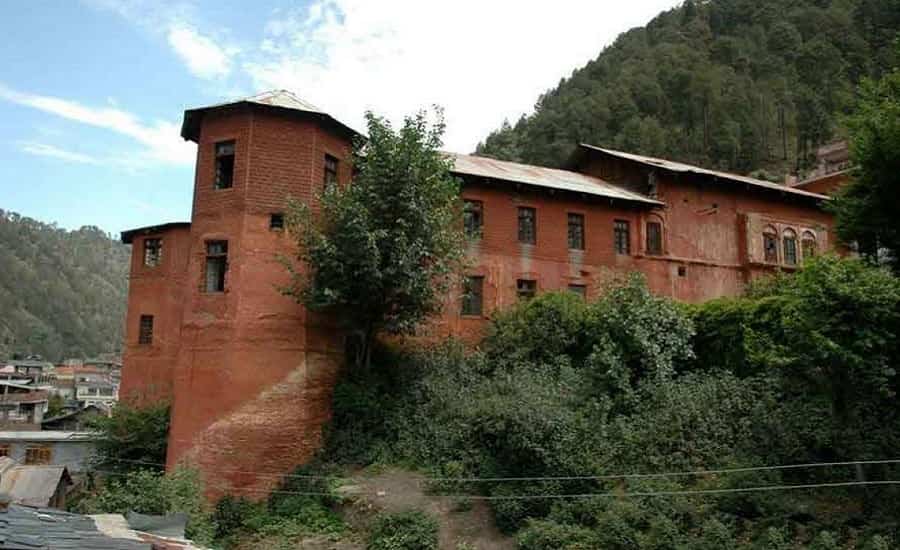
Rang Mahal attracts plenty of tourists every year, who come to watch the history and beauty. The foundation of the palace was laid in the mid-eighteenth century by Umed Singh. The aim behind the erection of the Rang Mahal was to serve the king’s accommodation and to warehouse treasure and royal grain.
The architecture of Rang Mahal reflects Mughal influences. It also posses the Himachal Emporium, where one can purchase a traditional craft executed by the women of Chamba which are small clothes of very fine silk embroidery that dated back from 1000 years.
Now, Rang Mahal is government property which the Department of Handicraft uses as a work-shop for slippers, shoes etc. Different museums across India are all loaded with the bits and pieces that were left in the palace. The most extensive hill collections that belong to the Kangra School are very eye-catching paintings which follow the story of Lord Krishna. The carved and painted doors are the main attraction of the palace. The visiting timings for the tourists are from 10 am to 1 pm and 2 pm to 5 pm.
War Memorial
- Situated: Dharamshala, Himachal Pradesh, India
- In the Fond Memory of : After Independence War Fare Heroes of (Himachal Pradesh)
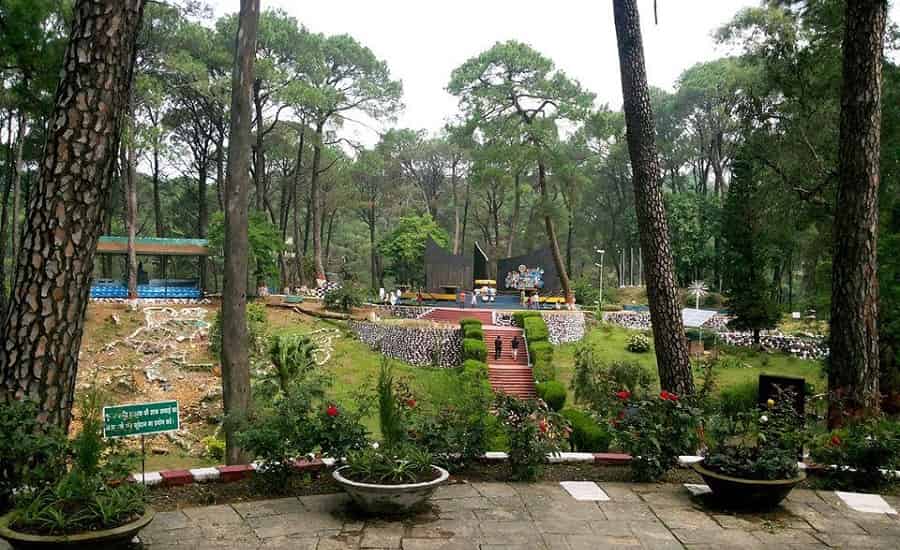
War Memorial is an embellishing doorway to the immense ancient city of (Dharamshala) that is an ideal place of verdant green and long pine trees, peace and amongst this gives a huge mark of respect to all the Brave War Heroes of Himachal Pradesh in the Era of Post Independence. These sufferers sacrificed their lives in the (Indo-China war of 1962), (the Indo – Pak wars of (1947, 1965 and 1971) and also during the (UN peace operations).
The structure of War Memorial is superbly bedecked and stroked with greenish lawns and artistic landscaping. This place adorns a feeling of patriotism amongst the tourists. You can also enjoy some nice beverages at a restaurant located just adjacent to the memorial.
Lord Elgins Memorial
- Region: Himachal Pradesh, Dharamshala
- Special Characteristic: St. John’s church inside portion contains the memorial.
- Constructed In : 1860
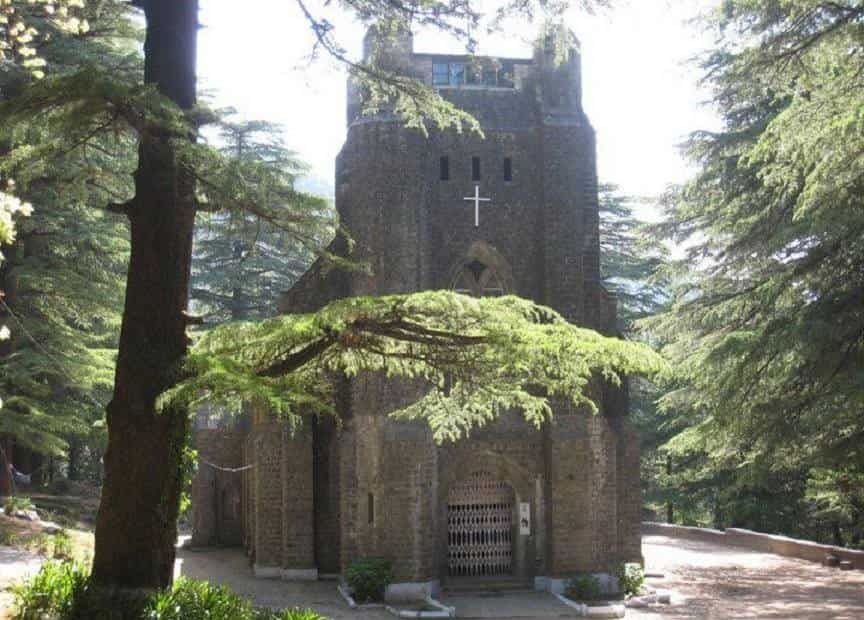
After India’s 1st war for independence, the Empress of India honor was dedicated to Queen Victoria. Lord Canning, the Prime minister had made this declaration and the title of Governor General was enhanced to India’s Viceroy. During that time, Delhi’s respected capital was Shimla, rest of the delightful spots got the unofficial support’s complete quota over Himachal Pradesh`s hills like Sanawar, Dagshai, Shimla etc. the schools also got the elegant Gothic Cathedrals look along with glass windows, displaying various scenes of Jesus Christ’s life and aged testament. Here you will also get to see the reproduced popular religious Sir Christopher Wren’s Architecture he had constructed the St. Pauls within London and many other places.
If you travel for eight kilometers ahead from the village, you will get to see a very adorable and classic St. John church, this holy church includes a few window’s that have expensive stained glass. One of the panels displays Christ and St. John the Baptist. The location was Dharamshala where the Scottish peer, Lord Elgins Memorial and 8th viceroy all these people got success in achieving Lord Lansdowne during the year of 1896. The entire charm of the area along with mountains and lakes were loved by Lord he remember his native house that is located at beautiful Scotland wild, rugged and beautiful. He had not completed his term of 4 years, and suddenly he left this world on the place which he truly loved that is Dharamasala.
He died during the year of 1862, before that he requested his followers to bury his body in St. John church, which is committed to supporter sage of Scotland, this holy structure was constructed during 1860. There is a monument within the church that was built in the honor of the Viceroy, he came to this place to rule over this region but he remained after his death also.
Norbulingka Institute
- Region : Himachal Pradesh, from Dharamshala about four kilometers far
- Major Attractive Features : Museum and temple, Nunnery
- Showcasing : Thangka paintings and wooden carvings

If you go ahead from Dharamshala, after crossing a distance of four kilometers you will reach another massive monument that is Norbulingka. The first thing which you observe in the monument is the presence of Japanese culture through wooden bridges, shady paths, little streams small waterfalls all these elements have given a heaven look to this monument. This monument of Tibetan Culture was established through the initiative of the Department of Culture and Religion, the motto behind making this monument was very simple and clear, to store and publish Tibetan culture and art in exile.
The first interest generating aspect of this institute is its unique name, Norbulingka. This name was inspired from the sacred and beautiful home of Dalai Lama, the meaning of this word is suitable to the entire look of this monument that is Jewel Garden, and his divine summer home is located in parkland, the distance from Macleod Ganj or Lhasa towards his house is only 2 kilometers.
To preserve the great future of Tibet, the 7th Dalai Lama who was famous as Kelsang Gyatso had founded the institute of science and arts during the year of 1754. Dharamsala’s Norbulingka Institute has come forward to store the precious and strong base of the culture of Tibet in banish. The moment this institute will be completed, this will embrace the Center of bigger Tibetan Learning. Don’t forget to visit the garden area of Norbulingka institute, it comprises of museums, traditional temple that contains paintings of Thangka, carpet weaving, carved woodwork and many more multicolored crafts.
You can observe these crafts and you can also buy these crafts which have been presented in the boutique area of the Institute. Near the institute you will find a nunnery; here you can get the opportunity to learn Buddhist philosophy’s higher levels; which will actually help you to live your life more meaningfully. This place is easily accessible from McLeod Ganj.
Tabo Monastery Spiti
- Situation : 46 kms east of Kaza, Spiti Valley, Himachal Pradesh
- Established In : 996 AD
- Domiciles : Deva Gyatsho

Tabo Monastery is mentioned as Tabo Chos-Khor ‘doctrinal enclave’ the monks chamber is held by this complex, nine shrines, chortens which are 23 in numbers, this has an extension with the nuns houses of chambers. The great teacher, brainchild and translator of the Tabo are Rinchensang-Po. There are several caves on the cliffs which are the dwelling place of monks; this was also called as the ‘assembly hall’.
Buddha’s life is depicted from the stucco and wall paintings; you can also see the life depiction of Buddha in buildings like the ‘Ser-Khang’ or ‘Golden Temple’. Tabo Monastery was renovated in the sixteenth century with gold layers by the ruler of Ladakh, Sengge Namgyal has fine-looking murals demonstrative walls and ceilings. In the shrine of Bodhisattva Maitreya of Tabo Monastery is the idol of an height of approximately more than six meters of Lord Bodhisattva Maitreya. The glimpse of instigation monk hood can be sensed in the ‘Mystic Mandala Temple’. On the north side of the shrine of Dromtön is the complex with imperative Atisha’s disciples.
The inner walls are enclosed through murals and are elaborately carved; Dromton founded this in 1008 – 1064 AD. The Brom ston lha khang covers the area of 70 sq meters and is the 2nd largest shrine and after visiting here you can have a glimpse of the idols of Shakyamuni, laid by Sariputra and Maha Maugdalayana are depicted on the walls of the outer and front side. On the other walls you can see the figures of the guardians. On the ceiling there are painted wooden planks. The shielding deity of the Gelukpa sect is found at the shrine of Mahakala Vajra-bhairava.
Maharaja Palace
- Location : Chail
- Constructed In : 1891
- Altitude Location : 2,250 meter
- Special Feature : One tiniest hill resort of Himalaya

Among the hill resorts of Himalaya, this is a tiniest resort; on a height of two thousand two hundred fifty meter the Chail is located. The moment Patiala’s King Bhupinder Singh was barred from Shimla, he took the decision to build his personal summer capital that was Chail. The selection of Chail was absolutely correct; this location is a thick wrap of royal, bounded by towering deodars. From Chail, you can reach Shimla in very less time because it is only forty five kilometers away. The Chail hill is comparatively bigger than Shimla which was under the British rule.
From Chail’s downtown area the highest point is around 1.5 kilometers, the peak point is at eight thousand feet. The down area of Chail is renowned for temple of Sidh Baba. As per the legend, this location is situated among the wide deodar mountain; it was an actual location of the King’s palace. But the sage manifested in the dream of the Maharaja and estimated that this location is holy because this was the spot where he meditated. On the next day, he moved his palace and decided to construct a beautiful Temple in the respect of Sidh.
During the year of 1891, the construction of Maharaja Palace was finished; the entire look of the palace was splendor, it was adorned by delicate and classic furnishing. With relaxed bug cottages and huts, tranquil walks and wide forests, Children’s Park, extensive lawns, sport facilities and lovers hill and the entire tremendous palace was decorated. If you deeply observe Chail, you will find that actually this place is a resort. You can stay in one of the surrounded cottages or huts, because the tariff is very cheap. There are 4 rooms in Rajgarh cottage. You can also take the entire cottage on rent along with the kitchen and dining room.
There are double rooms in Monal Cottage, Wood Rose Cottage and big huts with kitchen. This is the perfect place for honeymooners. This hill resort serves you interesting and amazing opportunity to have the fun of trekking and fishing, here you can also enjoy cricket on the highest cricket pitch of the world & a polo ground.
Viceregal Lodge
- Situated : Shimla, (Himachal Pradesh), India
- Constructed in the Year : 1888
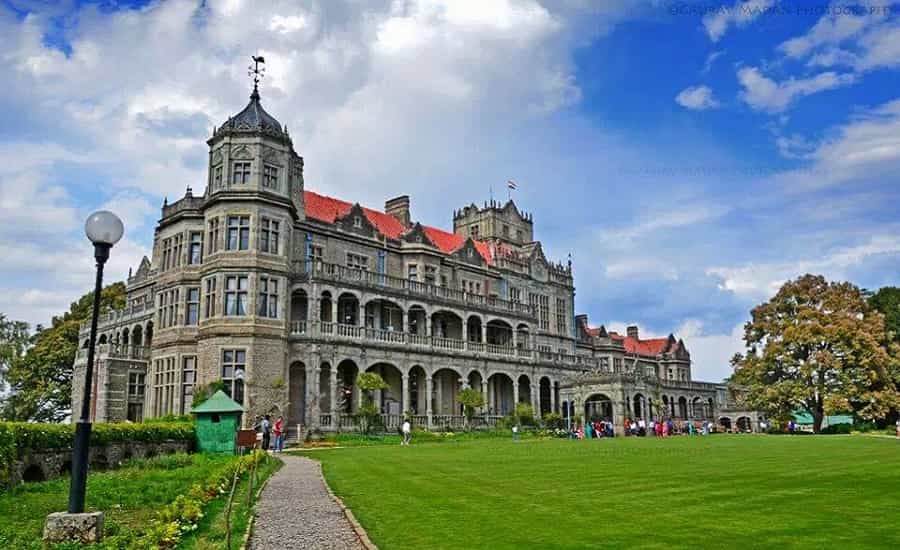
Viceregal Lodge, acknowledged as (Rashtrapati Niwas), is situated above the ancient Observatory Hills, and was known to be the abode of the prestigious British Viceroy, Lord Dufferin. Viceregal building was a very important spot for many significant decisions that had tainted the fortune of the sub continent. The building of Viceregal Lodge lays just two kms from the huge Himachal State Museum. This is a unique lodge in Shimla, which occupies a complete hill in Shimla. Currently this building is been used by The Indian Institute of Advanced Study.
The style of this building is inherited from Scotland and this memorial was intended by 1 of the designer Henry Irvine, Department of Public Works of the (colonial government). At the Southern direction, there is a large aperture to the doorway, which escorts to the beautiful reception hall, which is placed by a majestic escalating staircase and fireside. All the mud bricks that were utilized for the construction were specially brought from mules. Viceregal Lodge boosts 6 stories.
Viceregal Lodge’s gallery is made out of Teak that further shows the way to the ballroom, wooden wainscoted dining room and drawing room, that displays coats of arms of the past Viceroys and Governor – Generals. The subordinate levels of this palatial structure unlock the rambling lawns, whilst the higher floors presents birds eye sights of snow – clad mountains and becharming sunrises and sunsets.
Viceregal Lodge possessed facilities like electric lights, wine cellar, cold running and hot running bathrooms, boilers, laundry and indoor tennis. Copious social gathering were also prearranged during that moment to amuse the imperial people.
